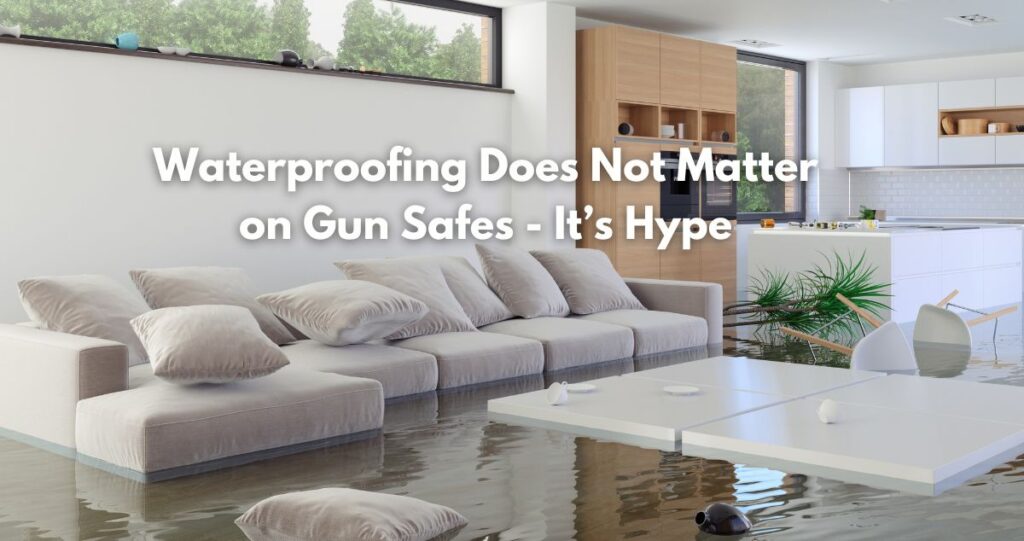
Gun safes do not need to be waterproof to be effective and protect your firearms, and being waterproof likely will not protect your guns from water damage as the main cause would either be a natural flood that can take days until it is safe for you to return home, or a fire where the sprinklers or fire hoses flooded your home. In addition to water, heat damage may already have occurred. Waterproof ratings on gun safes are nothing more than marketing hype the same way that fire proof ratings on gun safes no longer matter.
100 years ago fires would engulf a home and burn it to the ground. The intense heat would warp metal and destroy firearms which is why fireproof ratings used to be important. Waterproofing plays off of irrational fears, and these fears enable safe manufacturers to charge more money through marketing hype.
In fact there is no industry standard for waterproofing or ratings on gun safes. Each company can assign, test, and name their own. There was a legitimate need for fire ratings at one point, so two trusted third parties became industry standards, waterproofing has never been a legitimate concern which is why there aren’t any for this need. Let’s jump in and myth bust a bit.
It starts with some facts that marketers use to convince you to buy a waterproof gun safe at a premium price by making it sound like a “necessity”:
- 90% of natural disasters involve flooding and 1 inch of flood water can cause $27,000 in damage
- Floods can occur within minutes, and do not need to take days or weeks to cause damage. And only a few inches of rain can cause damaging floods according to the NSSL NOAA National Severe Storms Laboratory (NOAA).
- After a severe flood it could be days or weeks before it is safe to return home, and that means your safe can be submerged and have moisture leaked in causing mold and corrosion to begin before you can stop it.
The Depth and Time Numbers on the Rating
The depth and time numbers on a waterproof rating represent how long the safe is supposed to protect the contents inside when it is fully submerged, and at a maximum depth of water. If your safe says 60 minutes at 48 inches, you have 1 hour of protection in 4 feet of water. 72 hours at 36 inches would be 3 days in 3 feet of water.
This sounds good, and chances are the safe will hold up, but what would a real life situation look like? The time before you can return back home after a large fire that has flooding or a natural disaster with flood waters will depend on:
- Structural damage
- Contamination
- Mold
- The materials your home is built with
- Potential threats like electricity being ruled out by local officials including the fire department and FEMA in severe cases
In many cases it could be weeks before it is safe to return home, and floods can easily last for weeks. If you’re in an area that had storm surges, dams break, ice melting or rain causing rivers to offer flow, chances are you won’t be home in time to get the safe out of the water. And that goes to our next point.
Safes Need Ventilation
Most safes need ventilation to help prevent corrosion from damaging your firearms. Rusting and corrosion can start instantly as it only takes water and oxygen. Even if rust doesn’t start, mold can begin growing in as little as 24 hours according to FEMA. Ventilation can leak water in during a flood, and even if there’s no visible signs of rust immediately, mold may have started as the moisture, air, and temperature could be a perfect growing scenario.
We mention mold because mold can also cause corrosion which can spread to or begin on your firearms so they begin corroding. Unless your safe is airtight, which means you have to ventilate it manually, chances are some water may seep in and begin the process, especially when your home has flooding.
Is the Safe in Your Basement or Upstairs?
One of the most important things to think about before splurging on a water proof gun safe is where the safe will be located. If it’s in your basement, there’s more chance of a flood than in your bedroom on the second floor of your home.
If your gun safes are for protection and upstairs or raised, you’ve reduced the chances of them being under water in a non-severe flood, or one that drains quickly.
Check Your Flood Risk Levels
You can have a flood map survey done to see the potential for rising water levels. You’ll get the flood plains mapped out and discover some of your major potential risk factors. Another way to determine your risk of a flood is to talk to your home insurance company.
Not a fan of the phone, no problem! Look at title records to see if any floods have occurred and they may include the height of the water. You cannot predict the future, but you can plan for it and see if the height of where your gun safe is located and when it may be exposed to long periods under water in a worst case situation.
Flood ratings and waterproofing on gun safes are more myth than reality, it’s a way to get you to spend more for a “peace of mind” that will likely not be helpful in the event of a major disaster. If spending extra money for that feeling of security is within your budget, go for it.
In reality, you’re fine without waterproofing on your gun safe, because if a situation were to arise that it would be underwater, there are multiple other factors outside of waterproofing that will come into play, and no safe will keep your guns safe when these happen.